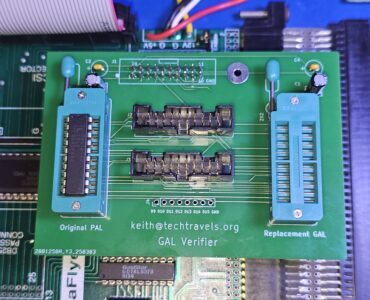There was a HDD backup utility for the Commodore Amiga called Quarterback, part of a suite of tools called Quarterback Tools. This utility allowed you to backup existing files on your HDD, compress and/or encrypt them...
Couple hi-res images of 16902A mainboard
I just recently added another HP/Agilent logic analyzer to my collection. This time it is the 16902A. I needed to remove the CPU tray to replace the IDE HDD with a SATA SSD. As a result, I figured I’d take couple...
Agilent Logic Analyzer cable teardown photos
So for today ladies and gentlemen, I present a teardown of an HP/Agilent logic analyzer cable. I think this is part number 16715-61601. This cable is used to connect one of a series of 40-pin compatible modules (many of...
Creating a timeline of events
It’s often useful when trying to understand, debug, or reverse engineer a system to put together a timeline of operation from beginning to end. The result is a series of events where something happens first, then...
Identify PAL inputs and outputs
In order to properly reverse engineer a PAL, you need to correctly identify which pins are inputs, and which pins are outputs. This in some cases is trivial because some of the PAL’s pin functions are fixed...
Understand the system
Of all of the different techniques this one may be the simplest but also the most important. When you’re trying to reverse engineer something, understanding the system is key to unraveling the black box which is...
Why simply “dumping” a PAL isn’t always possible?
Contents Rom Dumping Dumping ROMs is a pretty common practice in the space of reverse engineering, and many eeprom readers are cheap, easily available, and there’s really not much to them. Plunk your ROM chip in...
New Reverse Engineering PALs page
I’ve recently put a new page online on the site. It hosts a basic outline on different techniques to enable one to reverse engineering a PAL, and produce a modern equivalent. Right now, there are about a dozen...
My PAL stimulator
If you’ve been following my blog, you’ll see that I’ve been reversing a Commodore Amiga SCSI HDD Expansion card called the Dataflyer. On that Dataflyer, there’s a PAL that handles address...
Commodore Amiga AutoConfig expansion card process
Since I’ve been reverse engineering a DataFlyer Plus HDD SCSI expansion card for the Commodore Amiga, I’ve needed to get a much better understanding of how the AutoConfig process works. I’m by far no...
Dataflyer 500 reversed schematics are coming….
While trying to reverse the function of the Commodore Amiga Expansion Systems DataFlyer 500 BUSS PAL, I really needed to know what was connected to what. There are no, as far as I know(!!), schematics available for this...
Building a PAL reader for TL866A
So I’m in the process of trying to reverse engineer some custom PALs from a Commodore Amiga Dataflyer 500. It would be ideal to read those PALs directly, however I don’t have a compatible PAL reading...
Some reverse engineering notes on DataFlyer 500 BUSS Pal
As you may have seen in this other post here I have an interest in this Amiga hard drive controller designed for the Commodore Amiga 500. I used this for years to interface an HDD. At the time I took some photos of the...
2-wire digital voltage display accuracy
I had a few needs to for a simple voltage display that can handle the range of +5v to +12v. There’s a few different applications like displaying the state of a battery, a state of a power supply and so on. I was...
Refilling Star Micronics NX-1020 black ribbon ink cartridges
I have an old Star Micronics NX-1020 Rainbow printer from circa 1993. I bought this printer using my paper route Christmas money that I saved up for months. The printer served me valiantly throughout the early 90s. This...
HP Agilent 5382A tear down with photos
I recently tore down an Agilent E5382A Flying Lead Set. I used a Torx T-4 bit to remove the (4) tiny tiny screws. This adapter has a 90-pin connector that comes from HP logic analyzer cards, and then goes out to single...
Setting up a SCSI2SD on HP 167xxA for CDROM and HDD targets
This quick guide contains instructions on how to setup, configure, burn, and launch an install from a SCSI2SD when inserted into an HP/Agilent Logic Analyzer on the 16700 series. A fresh install is always recommended...
Evaluating Battery Backup Solutions for CPAP machines
I recently had a need to provide a battery backup solution for a CPAP machine. A CPAP machine helps people, who suffer from sleep apnea, get a good night’s rest. About 20 million Americans suffer from this...








